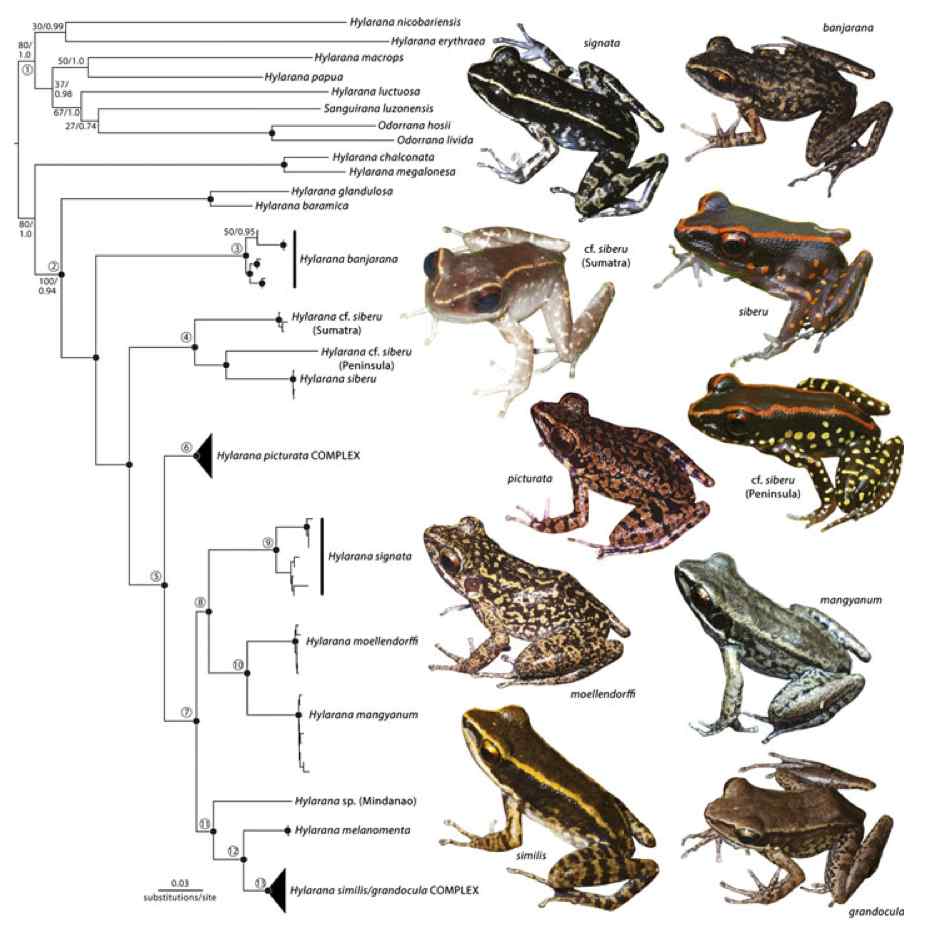Hylarana Southeast Asian Faunal Exchange

Introduction
A large array of species can accumulate on islands because the organisms that end up colonizing (establishing a new population in) these new habitats are physically separated from the original population they branched off from and thus proceed on their own evolutionary course. Successful colonization is affected by many factors, including ocean currents, competition between organisms, and the reproductive, behavioral, and body characteristics of the colonizing individuals.
New studies are showing that we can compare the diversification of species on mainland systems versus nearby island archipelagos. Contrary to expectation, recent studies have showed a greater level of species or lineage diversity in continental systems than island archipelagos. It is coming to light that the conditions of prehistoric Southeast Asia were quite variable and many mainland vertebrates were relatively limited in their ranges. We are also realizing that amphibians are able to and frequently do cross stretches of ocean. Studies regarding the mainland and island distribution of amphibian groups are important in light of these recent discoveries.
Philippine animals are distinct from, or somewhere in-between, those of the Sunda Shelf land-bridge islands of Southeast Asia and those of Australia’s oceanic islands. Scientists have come up with four or five possible main ways in which animals have come to inhabit the oceanic portions of the Philippine archipelago. There were probably two chains of islands that served as land-bridges by which animals could get to the Philippines from present-day Borneo. There is a third southern route via the Shangihe-Talaud-Sarangani island chain from the south-east that may have been followed, as well as a fourth possible northern entryway via the Taiwan-Batanes-Babuyans island chain. Some lineages also possibly originated in the archipelago from geological events, such as tectonic plate movements which physically separate land formations, though this is not certain. All of these routes have been supported by some evidence, though there has been limited evidence in support of the northern and south-eastern dispersal routes. Most studies favor overland and island-chain dispersal along long western and eastern Philippine islands.
A ‘dual-invasion’ hypothesis suggests the occurrence of two independent events which moved animals across these land-bridge islands could have resulted in the archipelago-wide presence of species found only in the Philippines. Our research aimed to bring new tools and technology to the study of spotted stream frogs. We found a surprising level of genetic diversity which points to the possible presence of multiple hidden species, and the ‘dual-invasion’ model seems be an accurate explanation for the diversity we see in the Philippines.
Materials and Methods
We sampled 160 individual frogs from 86 locations and ran tests to determine levels of genetic diversity and relationships between these frogs and others.
Discussion
If the lineages our tests produced are correctly identified as distinct species, our new findings suggest that a greater number of species may be present on the Asian mainland and its land-bridge islands than in the adjacent Philippine archipelago. In the Asian mainland and land-bridge islands we found six recognized species with possibly three more within H. picturata for a total of ten species. In the adjacent Philippine archipelago there are five or six species present. We anticipate that future studies will recognize greater species diversity within populations now found on the Asian mainland and its adjacent land-bridge islands. Our research supports the dual-invasion scenario, suggesting that these stream frogs came to the Philippines through both the eastern (Mindanao–Luzon) and western (Palawan–Mindoro) island arcs.
Brown, R.M. and C.D. Siler. 2014. Spotted stream frog diversification at the Australasian faunal zone interface, mainland versus island comparisons, and a test of the Philippine ‘dual-umbilicus’ hypothesis. Journal of Biogeography 41: 182–195. pdf
